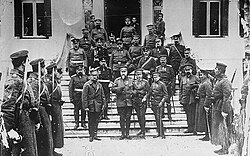
Back Russies-Japannese Oorlog Afrikaans الحرب الروسية اليابانية Arabic Guerra ruso-xaponesa AST Rus-yapon müharibəsi Azerbaijani روس-ژاپون ساواشی AZB Рус-япон һуғышы Bashkir Руска-японская вайна Byelorussian Руско-японска война Bulgarian রুশ–জাপান যুদ্ধ Bengali/Bangla Brezel etre Japan ha Rusia Breton
| Russo-Japanese War | |||||||
|---|---|---|---|---|---|---|---|
 Clockwise from top: Russian cruiser Pallada under fire at Port Arthur, Russian cavalry at Mukden, Russian cruiser Varyag and gunboat Korietz at Chemulpo Bay, Japanese dead at Port Arthur, Japanese infantry crossing the Yalu River | |||||||
| |||||||
| Belligerents | |||||||
| Commanders and leaders | |||||||
| Strength | |||||||
|
1,365,000 (total)[1]
|
1,200,000 (total)[1]
| ||||||
| Casualties and losses | |||||||
|
Total:43,300–71,453 dead [2][3]
146,032 wounded 8 battleships sunk 2 battleships captured |
Total: 80,378–86,100 dead [2][3]
2 battleships sunk | ||||||
| Events leading to World War I |
|---|
 |
|
The Russo-Japanese War (Japanese: 日露戦争, romanized: Nichiro sensō, lit. 'Japanese-Russian War'; Russian: русско-японская война, romanized: russko-yaponskaya voyna) was fought between the Empire of Japan and the Russian Empire during 1904 and 1905 over rival imperial ambitions in Manchuria and the Korean Empire.[4] The major theatres of military operations were in the Liaodong Peninsula and Mukden in Southern Manchuria, the Yellow Sea and the Sea of Japan.
Russia sought a warm-water port on the Pacific Ocean both for its navy and for maritime trade. Vladivostok remained ice-free and operational only during the summer; Port Arthur, a naval base in Liaodong Province leased to Russia by the Qing dynasty of China from 1897, was operational year round.
Russia had pursued an expansionist policy east of the Urals, in Siberia and the Far East, since the reign of Ivan the Terrible in the 16th century.[5] Since the end of the First Sino-Japanese War in 1895, Japan had feared Russian encroachment would interfere with its plans to establish a sphere of influence in Korea and Manchuria. Seeing Russia as a rival, Japan offered to recognize Russian dominance in Manchuria in exchange for recognition of the Korean Empire as being within the Japanese sphere of influence. Russia refused and demanded the establishment of a neutral buffer zone between Russia and Japan in Korea, north of the 39th parallel. The Imperial Japanese Government perceived this as obstructing their plans for expansion into mainland Asia and chose to go to war. After negotiations broke down in 1904, the Imperial Japanese Navy opened hostilities in a surprise attack on the Russian Eastern Fleet at Port Arthur, China on 9 February [O.S. 27 January] 1904. The Russian Empire responded by declaring war on Japan.
Although Russia suffered a number of defeats, Emperor Nicholas II remained convinced that Russia could still win if it fought on; he chose to remain engaged in the war and await the outcomes of key naval battles. As hope of victory dissipated, he continued the war to preserve the dignity of Russia by averting a "humiliating peace". Russia ignored Japan's willingness early on to agree to an armistice and rejected the idea of bringing the dispute to the Permanent Court of Arbitration at the Hague. After the decisive naval battle of Tsushima, the war was concluded with the Treaty of Portsmouth (5 September [O.S. 23 August] 1905), mediated by US President Theodore Roosevelt. The complete victory of the Japanese military surprised international observers and transformed the balance of power in both East Asia and Europe, resulting in Japan's emergence as a great power and a decline in the Russian Empire's prestige and influence in Europe. Russia's incurrence of substantial casualties and losses for a cause that resulted in humiliating defeat contributed to a growing domestic unrest which culminated in the 1905 Russian Revolution, and severely damaged the prestige of the Russian autocracy.
- ^ a b Mitchell, T. J.; Smith, G. M. (1931). Casualties and Medical Statistics of the Great War. London: Her Majesty's Stationery Office. p. 6. OCLC 14739880.
- ^ a b Dumas, S.; Vedel-Petersen, K.O. (1923). Losses of Life Caused By War. Oxford: Clarendon Press. pp. 57–9.
- ^ a b Matthew White. "Mid-Range Wars and Atrocities of the Twentieth Century – Russo-Japanese War". Historical Atlas of the Twentieth Century. Archived from the original on 10 September 2017. Retrieved 17 October 2013.
- ^ Kim, Samuel S. (26 June 2006). The Two Koreas and the Great Powers. Cambridge University Press (published 2006). p. 2. ISBN 9781139455435. Archived from the original on 27 June 2021. Retrieved 11 January 2021.
... imperial Japan was at the forefront of hegemonic wars in a quest to extend the Japanese hegemony over Korea to the entire Asia-Pacific region – the Sino–Japanese War of 1894–95 to gain dominance in Korea, the Russo-Japanese War of 1904–5 for mastery over Manchuria and Korea ...
- ^ Steinberg 2008, p. 2.
© MMXXIII Rich X Search. We shall prevail. All rights reserved. Rich X Search